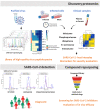Proteomics in the COVID-19 Battlefield: First Semester Check-Up
- PMID: 33236484
- PMCID: PMC7744874
- DOI: 10.1002/pmic.202000198
Proteomics in the COVID-19 Battlefield: First Semester Check-Up
Abstract
Proteomics offers a wide collection of methodologies to study biological systems at the finest granularity. Faced with COVID-19, the most worrying pandemic in a century, proteomics researchers have made significant progress in understanding how the causative virus hijacks the host's cellular machinery and multiplies exponentially, how the disease can be diagnosed, and how it develops, as well as its severity predicted. Numerous cellular targets of potential interest for the development of new antiviral drugs have been documented. Here, the most striking results obtained in the proteomics field over this first semester of the pandemic are presented. The molecular machinery of SARS-CoV-2 is much more complex than initially believed, as many post-translational modifications can occur, leading to a myriad of proteoforms and a broad heterogeneity of viral particles. The interplay of protein-protein interactions, protein abundances, and post-translational modifications has yet to be fully documented to provide a full picture of this intriguing but lethal biological threat. Proteomics has the potential to provide rapid detection of the SARS-CoV-2 virus by mass spectrometry proteotyping, and to further increase the knowledge of severe respiratory syndrome COVID-19 and its long-term health consequences.
© 2020 Wiley-VCH GmbH.
Conflict of interest statement
The authors declare no conflict of interest.
Figures



Similar articles
-
Proteomic Approaches to Study SARS-CoV-2 Biology and COVID-19 Pathology.J Proteome Res. 2021 Feb 5;20(2):1133-1152. doi: 10.1021/acs.jproteome.0c00764. Epub 2021 Jan 19. J Proteome Res. 2021. PMID: 33464917 Free PMC article.
-
Proteomics-Based Insights Into the SARS-CoV-2-Mediated COVID-19 Pandemic: A Review of the First Year of Research.Mol Cell Proteomics. 2021;20:100103. doi: 10.1016/j.mcpro.2021.100103. Epub 2021 Jun 4. Mol Cell Proteomics. 2021. PMID: 34089862 Free PMC article. Review.
-
Open Science Resources for the Mass Spectrometry-Based Analysis of SARS-CoV-2.J Proteome Res. 2021 Mar 5;20(3):1464-1475. doi: 10.1021/acs.jproteome.0c00929. Epub 2021 Feb 19. J Proteome Res. 2021. PMID: 33605735 Review.
-
COVIDomics: The Proteomic and Metabolomic Signatures of COVID-19.Int J Mol Sci. 2022 Feb 22;23(5):2414. doi: 10.3390/ijms23052414. Int J Mol Sci. 2022. PMID: 35269564 Free PMC article. Review.
-
The Ineluctable Role of ACE-2 Receptors in SARS COV-2 Infection and Drug Repurposing as a Plausible SARS COV-2 Therapy: A Concise Treatise.Curr Mol Med. 2021;21(10):888-913. doi: 10.2174/1573405617666210204212024. Curr Mol Med. 2021. PMID: 33563197 Review.
Cited by
-
Heterogeneity of SARS-CoV-2 virus produced in cell culture revealed by shotgun proteomics and supported by genome sequencing.Anal Bioanal Chem. 2021 Dec;413(29):7265-7275. doi: 10.1007/s00216-021-03401-9. Epub 2021 May 20. Anal Bioanal Chem. 2021. PMID: 34013402 Free PMC article.
-
N-glycosylation profiles of the SARS-CoV-2 spike D614G mutant and its ancestral protein characterized by advanced mass spectrometry.Sci Rep. 2021 Dec 7;11(1):23561. doi: 10.1038/s41598-021-02904-w. Sci Rep. 2021. PMID: 34876606 Free PMC article.
-
Application of spectral library prediction for parallel reaction monitoring of viral peptides.Proteomics. 2021 Apr;21(7-8):e2000226. doi: 10.1002/pmic.202000226. Epub 2021 Mar 30. Proteomics. 2021. PMID: 33615696 Free PMC article.
-
Taxonomical and functional changes in COVID-19 faecal microbiome could be related to SARS-CoV-2 faecal load.Environ Microbiol. 2022 Sep;24(9):4299-4316. doi: 10.1111/1462-2920.16028. Epub 2022 May 9. Environ Microbiol. 2022. PMID: 35506300 Free PMC article.
-
SOD1 is a Possible Predictor of COVID-19 Progression as Revealed by Plasma Proteomics.ACS Omega. 2021 Jun 24;6(26):16826-16836. doi: 10.1021/acsomega.1c01375. eCollection 2021 Jul 6. ACS Omega. 2021. PMID: 34250342 Free PMC article.
References
-
- Zhou P., Yang X. L., Wang X. G., Hu B., Zhang L., Zhang W., Si H. R., Zhu Y., Li B., Huang C. L., Chen H. D., Chen J., Luo Y., Guo H., Jiang R. D., Liu M. Q., Chen Y., Shen X. R., Wang X., Zheng X. S., Zhao K., Chen Q. J., Deng F., Liu L. L., Yan B., Zhan F. X., Wang Y. Y., Xiao G. F., Shi Z. L., Nature 2020, 579, 270. - PMC - PubMed
-
- Armengaud J., Expert Rev. Proteomics 2020, 17, 507. - PubMed
Publication types
MeSH terms
Substances
Grants and funding
LinkOut - more resources
Full Text Sources
Medical
Miscellaneous

